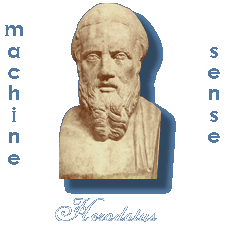| C r y p t o l o g y : H e r o d o t u s |
The only good is knowledge, and the only evil is ignorance. |
 |
Herodotus of Halikarnassos (present day Turkey) lived around 500 BCE. A well-travelled historian and storyteller, he wrote an account of his observations in The Histories, which describes the expansion of the Achaemenid empire. Despite doubts as to the provenance and accuracy of his stories, he is sometimes regarded as "The Father of History". |
|
In The Histories, Herodotus describes three incidents involving steganography: Demaratos warned the Lacedemonians about an impending attack by writing the warning on a wooden tablet and covering it in wax. When the wax tablet reached the Lacedemonians, they scraped the wax off and read the warning. From The Histories of Herodotus: When Xerxes had resolved to make a campaign against Hellas, Demaratos, being in Susa and having been informed of this, had a desire to report it to the Lacedemonians. Now in no other way was he able to signify it, for there was danger that he should be discovered, but he contrived thus, that is to say, he took a folding tablet and scraped off the wax which was upon it, and then he wrote the design of the king upon the wood of the tablet, and having done so he melted the wax and poured it over the writing, so that the tablet (being carried without writing upon it) might not cause any trouble to be given by the keepers of the road. Then when it had arrived at Lacedemon, the Lacedemonians were not able to make conjecture of the matter; until at last, as I am informed, Gorgo, the daughter of Cleomenes and wife of Leonidas, suggested a plan of which she had herself thought, bidding them scrape the wax and they would find writing upon the wood; and doing as she said they found the writing and read it, and after that they sent notice to the other Hellenes. |
|
Another incident involves Histiaios who sent a signal to Aristagoras that he should revolt against the Persians. Histiaos shaved the head of his most trusted slave and tattooed a message on it. As soon as the hair had grown back, the slave was sent to Aristagoras. From The Histories of Herodotus: For Histiaios, desiring to signify to Aristagoras that he should revolt, was not able to do it safely in any other way, because the roads were guarded, but shaved off the hair of the most faithful of his slaves, and having marked his head by pricking it, waited till the hair had grown again; and as soon as it was grown, he sent him away to Miletos, giving him no other charge but this, namely that when he should have arrived at Miletos he should bid Aristagoras shave his hair and look at his head: and the marks, as I have said before, signified revolt. |
|
The third description of steganography is found in the story of Harpagos who sent a message hidden in the belly of a hare. From The Histories of Herodotus: Harpagos wishing to make known his design to Cyrus, who lived among the Persians, could do it no other way, seeing that the roads were watched, but devised a scheme as follows:--he made ready a hare, and having cut open its belly but without pulling off any of the fur, he put into it, just as it was, a piece of paper, having written upon it that which he thought good; and then he sewed up again the belly of the hare, and giving nets as if he were a hunter to that one of his servants whom he trusted most, he sent him away to the land of the Persians, enjoining him by word of mouth to give the hare to Cyrus, and to tell him at the same time to open it with his own hands and let no one else be present when he did so. This then was accomplished, and Cyrus having received from him the hare, cut it open; and having found within it the paper he took and read it over. |
|
Steganography is the art and science of hiding the existence of a message. Steganalysis is the art and science of detecting a hidden message. None of the incidents described by Herodotus involve any encryption. However, the messages are concealed before being sent. Upon receiving the messages, the recipients have to extract the hidden messages before they can read them. In each incident, the only protection mechanism is the fact that the message's existence is a secret. Once discovered, the message could be easily read. So the emphasis is on clever concealment of the message, rather than encryption mechanisms. In the digital age, steganography still operates under the same premise: Hide the fact that the message exists. You can hide a message or a file inside a picture, movie or sound file. Digital watermarking is a variation of steganography. |
| Related Topics | |
| Steganography |
The art and science of hiding the existence of a message. |
| External Links |
|
| The Histories of Herodotus vol 1 | Text at Project Gutenberg |
| The Histories of Herodotus vol 2 | Text at Project Gutenberg |
| Stegoarchive.com | Great collection of free and commercial steganography tools. Also has a selection of steganalysis tools. |